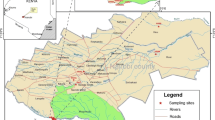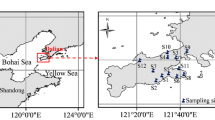Abstract
In a research project on risk management of harmful substances in water cycles, clindamycin and 12 further antibiotics were determined in different sewage samples. In contrast to other antibiotics, an increase of the clindamycin concentration in the final effluent in comparison to the influent of the sewage treatment plant (STP) was observed. A back transformation from the main metabolite clindamycin sulfoxide to clindamycin during the denitrification process has been discussed. Therefore, the concentration of this metabolite was measured additionally. Clindamycin sulfoxide was stable in the STP and the assumption of back transformation of the metabolite to clindamycin was confuted. To explain the increasing clindamycin concentration in the STP, the ratio of clindamycin sulfoxide to clindamycin was observed. The ratio increased in dry spells with concentrated samples and with long dwell time in the sewer system. A short hydraulic retention in waste water system and diluted samples in periods of extreme rainfall lead to a lower ratio of clindamycin sulfoxide to clindamycin concentration. A plausible explanation of this behavior could be that clindamycin was adsorbed strongly to a component of the sewage during this long residence time and in the STP, clindamycin was released. In the common sample preparation in the lab, clindamycin was not released. Measurements of clindamycin and clindamycin sulfoxide in the influent and effluent of STP is advised for sewage monitoring.

Similar content being viewed by others
References
Batt AL, Bruce IB, Aga DS (2006) Evaluating the vulnerability of surface waters to antibiotic contamination from varying wastewater treatment plant discharges. Environ Pollut 142:295–302
Brooks BW, Huggett DBE (2012) Human pharmaceuticals in the environment: current and future perspectives. emerging topics in ecotoxicology—principles, approaches and perspectives, 4. Springer Sciences + Business Media, New York
Kovalova L, Siegrist H, Singer H, Wittmer A, McArdell CS (2012) Hospital wastewater treatment by membrane bioreactor: performance and efficiency for organic micropollutant elimination. Environ Sci Technol 46:1536–1545
Kummerer K (2009a) The presence of pharmaceuticals in the environment due to human use—present knowledge and future challenges. J Environ Manage 90:2354–2366
Kummerer K (2009b) Antibiotics in the aquatic environment—a review—part I. Chemosphere 75:417–434
Langford KH, Thomas KV (2009) Determination of pharmaceutical compounds in hospital effluents and their contribution to wastewater treatment works. Environ Int 35:766–770
Schubert S, Rossmann J, Oertel R, Kirch W (in prep.): Simultaneous determination of most prescribed antibiotics in multiple wastewater by SPE-LC-MS/MS
Schubert S, Mühlbauer V, Oertel R, Knoth H, Kirch W (submitted): Risk potential of the most widely prescribed antibiotics in the hospital wastewater
Schwabe U, Paffrath D (2011) Arzneiverordnungs-Report 2011. Springer Medizin Verlag, Berlin, Heidelberg
Spongberg AL, Witter JD (2008) Pharmaceutical compounds in the wastewater process stream in Northwest Ohio. Sci Total Environ 397:148–157
Stackelberg PE, Gibs J, Furlong ET, Meyer MT, Zaugg SD, Lippincott RL (2007) Efficiency of conventional drinking-water-treatment processes in removal of pharmaceuticals and other organic compounds. Sci Total Environ 377:255–272
Verlicchi P, Al Aukidy M, Galletti A, Petrovic M, Barcelo D (2012) Hospital effluent: investigation of the concentrations and distribution of pharmaceuticals and environmental risk assessment. Sci Total Environ 430:109–118
Wynalda MA, Hutzler JM, Koets MD, Podoll T, Wienkers LC (2003) In vitro metabolism of clindamycin in human liver and intestinal microsomes. Drug Metab Dispos 31:878–887
Acknowledgments
The project ANTI-Resist (02WRS1272A) is funded by the German Federal Ministry of Education and Research within the initiative Risk Management of Emerging Compounds and Pathogens in the Water Cycle (RISKWa).
Author information
Authors and Affiliations
Corresponding author
Additional information
Responsible editor: Hongwen Sun
Rights and permissions
About this article
Cite this article
Oertel, R., Schubert, S., Mühlbauer, V. et al. Determination of clindamycin and its metabolite clindamycin sulfoxide in diverse sewage samples. Environ Sci Pollut Res 21, 11764–11769 (2014). https://doi.org/10.1007/s11356-013-2333-2
Received:
Accepted:
Published:
Issue Date:
DOI: https://doi.org/10.1007/s11356-013-2333-2




